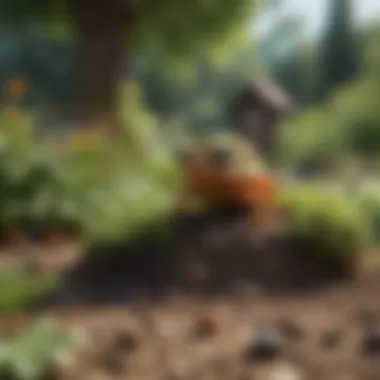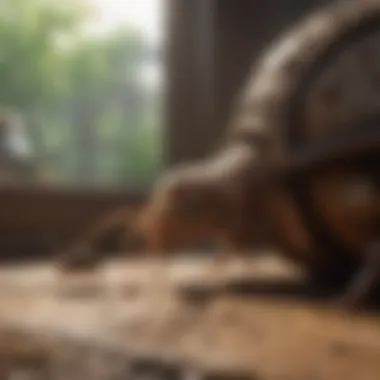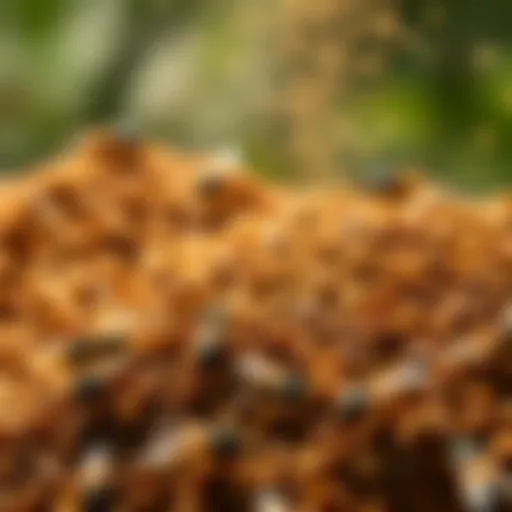The Essential Role of Pest Terminators in Modern Management


Intro
In the grand scheme of household maintenance, pest management often ends up on the back burner until those uninvited guests come knocking. It’s like that one leaky faucet you mean to fix but keep ignoring. A pest terminator, or a professional pest control expert, is not just a fancy title; it embodies a nuanced approach essential to maintaining a healthy living space. This article takes a closer look at how these professionals play a pivotal role in navigating the murky waters of pest management.
Understanding the complexities and the necessity of pest control begins with identifying exactly what we’re dealing with. From ants marching in a line to the ominous sight of a cockroach scuttling away, pests come in all shapes and sizes. Therefore, it’s vital to arm ourselves with knowledge, helping us manage these nuisances effectively and sustainably.
Understanding the Pest
Identification
Before jumping to solutions, recognizing the type of pest infiltrating your space is crucial. Each pest behaves differently based on its classification—be it rodents, insects, or other unwelcome tenants. A common misconception is that all bugs pose a similar threat. For instance, while termites might quietly chew away at your home’s foundation, bed bugs prefer more personal incursions, feasting on you while you sleep.
Quick tip: Keeping an eye out for droppings, nests, or visible damage can give a head start in identifying the problem. Checking resources like Wikipedia can also deepen understanding.
Life Cycle
Every pest has its own life cycle, which heavily influences their behavior, reproduction rates, and potential damage. For example, the life cycle of a fruit fly from egg to adult takes just about a week, leading to exponential growth if not managed promptly. Meanwhile, mice might breed several times a year but take longer to mature.
Being aware of these stages can inform pest control strategies, allowing for interventions during vulnerable periods. For example, disrupting their habitat during the larval stage, before they turn into full-fledged pests, can significantly improve success rates of extermination.
"Knowledge is your best ally in pest control; understanding your foe is often the key to winning the battle."
Pest Prevention Strategies
Environment Modification
The first line of defense in pest management often revolves around changing one's environment. This doesn’t mean turning your home into a fortress, but small tweaks can work wonders. Keeping food sealed and garbage secured, along with reducing clutter, helps eliminate breeding grounds. Additionally, ensuring proper drainage and sealing off entry points like cracks and openings can dramatically decrease the likelihood of infestations.
Physical Barriers
Another effective strategy involves physical barriers, such as traps or netting. Installing screens on windows and doors can keep winged pests out while a well-placed mouse trap can become the unsung hero in a rodent battle. It’s not about relying solely on methods, but arming yourself with multiple layers of defenses that create a fortress for your home.
Control Methods
Chemical Control
When prevention methods fall short, pest terminators often resort to chemical solutions. Professional-grade insecticides and rodenticides can be effective, but caution is key. It’s paramount to understand the implications of using these chemicals not only for pests but also for your household's health and the surrounding ecosystem. Applying these methods responsibly remains vital, minimizing risks while eliminating threats.
Biological Control
As many seek eco-friendly alternatives, biological control has gained traction. Introducing natural predators, be it ladybugs for aphids or certain nematodes for soil-dwelling pests, offers an effective strategy that maintains the ecological balance. This method relies less on harsh chemicals and can be familiarized with basic research, ensuring you’re on the right side of the environmental impact spectrum.
Prelims to Pest Management
Pest management stands as a crucial pillar in the maintenance of healthy living environments. The rising prevalence of pests in our homes and gardens presents not just an inconvenience but numerous health risks and potential damage to property. Understanding the nuances of pest control is invaluable for every homeowner looking to protect their sanctuary from these uninvited guests. This section lays the groundwork for delving deeper into the roles and responsibilities of pest terminators, focusing on what they contribute to modern pest management.
Defining Pest Terminator
A pest terminator is often viewed as the unsung hero of pest control. While the term might conjure images of intense extermination efforts, it encompasses a wide array of professionals and methods aimed at effective pest elimination. More than just a mere exterminator, a pest terminator applies scientific understanding and strategic planning to tackle various infestations, be they insects, rodents, or other nuisances. They are not just armed with sprays and traps; they use knowledge of pest behavior, habitat, and lifecycle to devise comprehensive control strategies. In essence, they serve as the first line of defense in maintaining the integrity of both our homes and our health.
Historical Context of Pest Management
Tracing back throughout history, pest management has evolved significantly. In ancient times, individuals relied on natural methods for pest removal, utilizing herbs, smoke, or even certain animal species as biological controls. Ancient Egyptians used cats to fend off rodents, while farmers in ancient China implemented a symbiotic approach, encouraging birds to eat harmful insects. As societies advanced, so did pest control methods. By the 19th century, chemical solutions began to emerge, altering the landscape of pest eradication dramatically. The introduction of synthetic pesticides revolutionized the industry but also sparked concerns over safety and environmental impacts. Today, the narrative of pest management is increasingly influenced by a quest for sustainability, as we grapple with the complexities that arise from our interactions with ecosystems.
Current Trends in Pest Control
Today's pest control landscape is a mix of tradition and technology, with modern pest terminators blending old wisdom with cutting-edge approaches. There is a marked shift toward integrated pest management (IPM), promoting a sustainable approach emphasizing prevention, monitoring, and limited intervention. Notably, homeowners are attracted to eco-friendly methods that curtail harmful chemicals, opting instead for traps, baits, and other non-toxic solutions.
Some emerging trends include:
- Smart technology: Innovations like smart traps and pest monitoring apps enable real-time surveillance and response.
- Drones for assessment: Using drones to inspect and assess larger areas, particularly in agricultural settings, has gained traction.
- Genetic controls: Research into genetically modified organisms that can disrupt pest reproduction represents a long-term solution that could be game-changing.
"The role of pest terminators has transformed from mere extermination to holistic pest management, focusing on prevention and sustainability."
In summary, pest management is not merely about exterminating pests. It’s a multi-faceted subject that brings together history, current methodologies, and future innovations, each playing a significant role in safeguarding our homes. Understanding this foundation sets the stage for a greater exploration of pest behaviors, control techniques, and the dedicated efforts of pest terminators.


Understanding Pest Behavior
Understanding pest behavior is crucial in modern pest management, especially as the relationship between humans and pests evolves. With changes in the environment, urbanization, and agricultural practices, pests have adapted and developed strategies to thrive alongside us. Therefore, grasping the intricacies of their behavior can lead to more effective pest control methods. This knowledge allows pest terminators to focus on prevention and extermination efforts that resonate with the specific habits and characteristics of various pests, promoting an overall healthier living space.
Common Types of Pests
Here, we delve into three common types of pests that every homeowner should be aware of: insect pests, rodent pests, and termites and wood-destroying insects. Each group possesses unique traits that necessitate tailored approaches for effective management.
Insect Pests
Insect pests, like ants and cockroaches, are notorious for their resilience and adaptability. One major aspect of insect pests is their ability to reproduce at alarming rates, making quick work of any food source. This characteristic makes them a popular focus in pest control discussions. For example, an ant colony can encompass countless members within a short period, resulting in an infestation that can overwhelm any home. Their advantage lies in their sheer numbers and social structures, which enable them to work collectively to exploit resources.
However, dealing with these pests requires a well-thought-out approach. Understanding their behavior allows homeowners to set effective traps and baits. Additionally, being aware of their feeding habits helps in identifying entry points—critical for any extermination plan.
Rodent Pests
Rodent pests, such as mice and rats, also demand a special spotlight in pest management. Their keen adaptability is what makes them so formidable. One can find them almost anywhere, from backyards to attics. Rodents are clever and often thrive in areas where food and shelter are easily accessible.
A key characteristic of rodent pests is their gnawing habits. These critters can chew through packaging, insulation, and even electrical wiring, causing significant damage. Because of this, it is crucial to have robust preventative measures in place. Understanding their habits—such as their preference for dark, sheltered places—can help homeowners to better secure their homes.
While traps and other mechanical devices play a significant role in eradicating these pests, leveraging knowledge of their behavior can lead to more strategic interventions.
Termites and Wood-Destroying Insects
Termites and wood-destroying insects present another layer of complexity in pest control. These pests are particularly concerning because they have the capability to cause extensive damage to homes and structures. Their silent and methodical eating can often go unnoticed until it’s too late.
What sets termites apart is their wood-digesting abilities; they possess symbiotic microorganisms in their guts that help break down cellulose. This unique feature allows them to thrive on wood-based materials, making them a significant threat to structural integrity.
Recognizing the telltale signs of termite activity—such as mud tubes and frass—enables timely intervention. Homeowners should periodically inspect wooden structures and consider preventative treatments. Knowledge of a termite’s life cycle can also aid in scheduling treatments that effectively reduce their populations.
Life Cycles and Behavioral Patterns
Reproductive Behaviors
The reproductive behaviors of pests are vital in understanding their population dynamics. Different pests employ varying reproductive strategies, from laying hundreds of eggs to forming colonies. This knowledge can shape pest management strategies by revealing the best times to treat infestations.
Feeding Habits
Feeding habits influence everything, from pest identification to control techniques. For instance, certain pests might be drawn to specific food sources or materials, while others may have more generalized diets. Grasping these habits aids in baiting and trapping methodologies.
Habitat Preferences
Habitat preferences dictate where pests live and breed. Some species prefer moisture-rich environments, while others thrive in arid conditions. This information is invaluable, as it allows homeowners to adapt their surroundings to make them less inviting to these unwanted guests.
Methods Employed by Pest Terminators
When it comes to pest management, the methods employed by pest terminators play a pivotal role in addressing infestations effectively. These methods can drastically affect the outcomes regarding both the health of the environment and the effectiveness of control efforts. Therefore, understanding these methods allows homeowners, especially those confused by pest issues, to make informed decisions that lead to a pest-free living space.
Chemical Pest Control Methods
Chemical pest control methods have long been at the forefront of pest management. They offer swift results and can effectively manage large infestations. These methods commonly include insecticides, rodenticides, and fumigation techniques. However, each has its own nuances, benefits, and downsides to consider.
Insecticides
Insecticides are chemical agents designed to kill insects. A significant aspect of insecticides is their specificity; many target only certain types of pests, thereby reducing collateral damage. This characteristic makes them a popular choice in pest management because they can be highly effective.
One unique feature of insecticides is their varying modes of action. Some disrupt the nervous system, while others interfere with hormonal systems in insects.
While they can wipe out a bug population swiftly, over-reliance might lead to pest resistance, making it crucial to blend them with other methods.
Rodenticides
Rodenticides specifically target rodent populations. They are usually effective in controlling mice and rats, which are known for carrying diseases. A noteworthy trait of rodenticides is their delayed action; this can prevent rodents from becoming suspicious and seeking other food sources.
Choosing rodenticides is common for homeowners dissatisfied with traditional traps. However, the risk lies in their potential impact on non-target species, especially pets or wildlife. Using these chemicals in a controlled manner is essential to mitigate any negative outcomes.
Fumigation Techniques
Fumigation techniques are often employed for severe infestations, especially those involving termites or bedbugs. This method involves sealing a structure and then introducing a gas that penetrates all areas, ensuring comprehensive coverage. What sets fumigation apart is its ability to eliminate pests that may not have been accessible through other means.
However, fumigation is not without challenges; it requires careful planning and execution. Homeowners must vacate their premises, and proper safety measures are critical to avoid harmful effects on humans and pets. Thus, while effective in many cases, it's essential to weigh the logistics and potential risks before closing the door on infestations with this technique.
Non-Chemical Pest Control Techniques
Non-chemical pest control techniques are becoming increasingly popular. They aim at managing pest populations while minimizing environmental impact. Techniques like traps and baits, physical exclusion, and cultural practices are key methods within this area. Each of these methods has its importance in helping to manage pest populations without adding further chemicals to the environment.


Traps and Baits
Traps and baits are an integral method in non-chemical pest control; they physically remove pests from a specified area. A primary advantage is their user-friendly nature – they can be set up with minimal expertise and can be tailored to specific pests. These traps can either be lethal or humane, allowing for a degree of flexibility in approach.
While traps and baits can effectively target pests, their limitations include the necessity of frequent checks and possible ineffectiveness for larger infestations if not used properly.
Physical Exclusion
Physical exclusion involves barriers that prevent pests from entering buildings. This method is essential for maintaining pest-free environments. Its primary benefit lies in its permanence; once a structure is properly sealed against pests, the chances of re-entry are greatly reduced.
However, the initial effort required to seal homes might feel daunting for some homeowners. Yet, this technique is often seen as the first line of defense and can drastically reduce reliance on other control measures.
Cultural Practices
Cultural practices refer to changes in habits and environmental adjustments that deter pests. These include sanitation practices such as managing waste and ensuring food is stored correctly. The key aspect here is prevention; practicing good sanitation can significantly reduce the likelihood of pest infestations.
One unique feature of cultural practices is their broad applicability; they can be tailored to specific pest issues or environmental conditions. Yet, it requires a commitment and ongoing vigilance from homeowners to cultivate a lasting impact.
Integrated Pest Management (IPM)
Integrated Pest Management, or IPM, takes a holistic approach by combining various control methods. It emphasizes the use of multiple strategies to address pest issues responsibly and effectively. This method is especially beneficial because it can lead to tailored solutions that minimize risks while achieving desired outcomes.
A major principle of IPM is monitoring – identifying pest populations before they become problematic. This proactive stance means that homeowners can address issues before they escalate, leading to cost-effective and sustainable management solutions. With an increased focus on environmental health and sustainability, IPM offers a way to navigate pest control while considering the broader ecological implications.
Ecological Considerations in Pest Control
Pest management goes beyond simply eliminating unwanted creatures. It’s about understanding how our actions affect the environment as a whole. Ecological considerations in pest control highlight the intricate balance within ecosystems and why managing pests should align with sustainable practices. This ensures that while we address pest issues, we do not unintentionally cause greater harm to our surroundings. Recognizing the impact of pest control measures on soil health, water quality, and non-target species gives insight into the broader implications of our methods.
Impact of Chemicals on Ecosystems
Soil Health
Soil health plays a crucial role in pest management strategies. Healthy soils support diverse microbial communities which can naturally suppress pest populations. When chemical pesticides are used excessively, they can degrade soil quality, leading to diminished fertility. In this article, focus on how maintaining soil health is not just an environmentally sound choice but also economically viable for homeowners. Soil's ability to retain moisture and nutrients can be compromised by toxic residues, which means it takes longer for gardens and crops to thrive.
Water Quality
Water quality is another key element influenced by pest control techniques. Runoff from treated areas can lead to contamination of nearby water sources, affecting both drinking water and aquatic ecosystems. It’s essential to highlight how maintaining clean water is vital for both human health and local wildlife. Sustainable pest control methods, perhaps integrating biocontrol solutions, can help keep water supplies safe and ensure that local flora and fauna continue to flourish. In summary, protecting water quality is interconnected with effective pest control.
Non-target Species
Non-target species are often overlooked in pest management dialogues. These species, which include beneficial insects and wildlife, can be unintentionally harmed by indiscriminate pesticide use. Highlighting the basic principle that not all insects are pests helps underscore the importance of selective pest management. An awareness that our pest control methods may jeopardize local biodiversity can lead to more thoughtful choices in strategies we adopt. Recognizing the unique value of non-target species, such as bees and ladybugs, enriches pest control discussions.
Beneficial Insects and Their Role
Beneficial insects are nature's allies in maintaining ecological balance. Their roles in pest control are invaluable, as they naturally mitigate pest populations without the need for chemicals, preserving the health of our ecosystems.
Pollinators
Pollinators like bees and butterflies are essential for the reproduction of many plants, including those in our own backyards. Their activity boosts crop yields and promotes biodiversity. Encouraging the presence of these insects through integrated pest management can facilitate a thriving garden ecosystem, ultimately lessening dependence on chemical solutions. This article illustrates how a considerate approach to pest control can enrich plant life and enhance food security for families.
Predators of Pests
Natural predators of pests, such as ladybugs and predatory wasps, play a significant role in controlling pest populations. By reducing reliance on chemical interventions, homeowners can see not only a decrease in pest populations but a resurgence of beneficial species. These predators work tirelessly to keep pest numbers in check, promoting a harmonized ecosystem. This article aims to demonstrate that nurturing predator populations could save costs in the long run while promoting a healthier environment.
Biocontrol Agents
Biocontrol agents are organisms used to control pest populations. This kind of intervention reduces the reliance on synthetic pesticides. While they may require a bit of strategy to establish effectively, the investment pays off in creating a balanced ecosystem. By harnessing natural processes, biocontrol agents can lead to sustainable pest management. This article will delve into the different types of biocontrol agents available, providing valuable insight into their practical applications for homeowners.
By considering these ecological aspects, pest control can become a more sustainable practice, benefiting not just our households, but the environment as a whole.
Future Perspectives in Pest Management
Understanding future perspectives in pest management isn't just a passing fancy—it's a nod to where the discipline is heading as society confronts increasing environmental and health challenges. The role of pest terminators is evolving, propelled by innovations and a greater awareness of sustainability. This fresh outlook encompasses various aspects, such as advanced technologies, regulatory frameworks, and the crucial involvement of community education.
Advancements in Pest Control Technologies
Smart Pest Control
Smart pest control refers to the integration of technological tools, like apps and sensors, into pest management practices. This approach is characterized by its precision and efficiency, striving to minimize the use of harmful chemicals. One key feature of smart control methods is the capability to monitor pest populations in real time. This means pest control strategies can be tailored based on actual data rather than on estimations. The benefit? Reduced reliance on chemical treatments and less waste.
However, using technology also comes with its own set of challenges. For instance, reliance on smart tools might lead to data overload or misinterpretation, which can be counterproductive.
Drones for Pest Management
Drones are making waves in pest management, offering an aerial perspective that’s hard to beat. They provide critical data collection, allowing pest terminators to assess infestations without stepping foot into infested areas. The key characteristic of drones is their ability to cover large areas quickly, mapping pest hotspots with ease. This efficiency makes them a popular choice in large agricultural settings.


On the flip side, drones can be pricey—both in purchase and operation. Local regulations regarding drone usage can also complicate their implementation, requiring pest management companies to navigate through the legal landscape.
Genetic Control Methods
Genetic control methods are another innovative approach gaining traction. This involves altering the genetics of pest populations to reduce their numbers or inhibit their reproduction. A significant advantage of this method lies in its potential for long-lasting effects, often requiring fewer interventions over time. What's remarkable is that these methods can be tailored to target specific pests, minimizing impacts on non-target species.
However, ethical concerns and ecological implications accompany genetic interventions. The potential for unintended consequences in ecosystems makes this a complex field that demands careful deliberation.
Policies and Regulations
National Policies
National policies play a fundamental role in shaping pest management practices. They ensure that pest control methods align with public health objectives and environmental sustainability. One notable aspect is the requirement for pest management companies to adhere to strict regulations regarding material use. This protective strategy not only aids in safeguarding public health but also supports responsible pesticide use.
The downside of national policies is that they can inadvertently stifle innovation. Striking a balance between regulation and flexibility in practicing new methods remains a vital consideration in pest management.
Sustainable Practices
Sustainable practices are gaining ground, emphasizing the need to control pests while preserving ecosystems. These practices often include organic pest controls, companion planting, and habitat manipulation. The focus on sustainability is vital as it addresses both the needs of pest management and the concerns of environmentally conscious homeowners.
However, adopting sustainable methods can sometimes involve higher upfront costs and may require more hands-on approaches from homeowners. Not every pest issue can be effectively remedied by these methods alone, thus necessitating a hybrid approach.
Public Awareness Initiatives
Raising public awareness about pest management is essential, as informed communities can play a crucial role in controlling infestations. Initiatives geared towards educating the public about effective pest prevention methods are vital. They empower homeowners to understand when to call an expert and the potential risks associated with certain treatments.
Nevertheless, public initiatives need funding and commitment to sustain. Achieving widespread engagement and maintaining that awareness can be a challenge, particularly in communities that face ongoing pest issues.
Community Involvement and Education
Workshops and Seminars
Organized workshops and seminars offer a hands-on opportunity for homeowners to learn about pest management. These gatherings are key in sharing knowledge and empowering communities to take control of pest issues. They can foster a sense of unity as members share experiences and solutions tailored to local challenges.
However, the effectiveness of these initiatives often hinges on community turnout and engagement. Without active participation, the advantages can be limited, leaving some issues unaddressed.
Online Resources and Training
The digital age has brought forth a wealth of online resources and training options, easily accessible to anyone seeking knowledge about pest control. This avenue allows homeowners to educate themselves at their convenience, equipping them with tools to tackle pest issues effectively.
Yet, while the internet provides vast knowledge, not all information is created equal. Sorting out fact versus folklore can create confusion, thus underscoring the need for reliable sources.
Collaborative Local Efforts
Lastly, collaborative local efforts in pest management are about community-driven initiatives that harness both individual and collective strengths. This collective action often leads to more efficient pest control measures and can build resilience against pests.
The challenge lies in coordination. Aligning goals among various stakeholders can be cumbersome, often slowing down progress. All in all, these local efforts require clear communication and shared objectives to be truly effective.
"Understanding how we manage pests today shapes the environment we live in tomorrow. Each innovation, policy, and community effort contributes to a healthier, more sustainable future."
As we look ahead, it's clear that pest management will continue to evolve, driven by technology, education, and community engagement. Agility in adapting to these changes will be critical for pest terminators to remain relevant and effective.
End
As we draw the curtains on the exploration of pest terminators’ vital role in modern pest management, it becomes evident just how indispensable these professionals are in maintaining the integrity of our homes and environments. Pest infestations can lead to significant damage, not just in terms of property but also to our health. Hence, understanding the multifaceted contributions of pest terminators is crucial for homeowners seeking effective solutions to pest problems.
Summarizing the Role of Pest Terminators
Pest terminators wear many hats — they are technicians, biologists, and sometimes even educators. Their expertise encompasses a vast array of methods and practices tailored to address various pest-related issues. From identifying pest types to assessing infestation levels, these experts rely on a wealth of knowledge. Furthermore, pest terminators integrate both chemical and non-chemical strategies in their work, making sure to choose approaches that align with the specific situation and environment.
Pest terminators serve not only as exterminators but also as advisors, guiding homeowners on preventive measures. They continually update their skills and knowledge about emerging technologies and evolving pest behavior. This adaptability ensures they remain effective allies in the ongoing battle against pests. In essence, pest terminators are essential partners for homeowners aiming to ensure a safe and pest-free living space.
The Importance of Sustainable Practices
In today’s world, sustainability is not just a buzzword; it's a necessity. Pest management practices should be designed with not only immediate results in mind but also with an eye toward environmental responsibility. By focusing on sustainable pest control methods, terminators not only help in mitigating pest issues but also contribute to the broader goal of environmental conservation.
Sustainable practices in pest management encompass the use of eco-friendly products, the promotion of beneficial organisms, and the implementation of practices that minimize disruption to the ecosystem. Here are a few key considerations:
- Less Chemical Dependency: Employing methods such as Integrated Pest Management (IPM) reduces reliance on harmful pesticides, protecting non-target species.
- Healthier Homes: Eco-friendly pest management practices decrease indoor chemical exposure, safeguarding your family's health, particularly for young children and pets.
- Long-term Solutions: Sustainable practices foster a balanced approach that can lead to lasting pest management solutions without adverse environmental impacts.
"Opting for sustainable pest control methods is a step not just for your home, but for the planet as a whole."
The role of pest terminators in promoting these sustainable practices cannot be overemphasized. They help bridge the gap between effective pest control and environmental stewardship, influencing homeowners to adopt responsible management strategies well beyond their service calls. This symbiotic relationship cultivates a healthier ecosystem for future generations.







